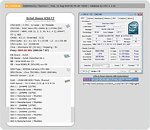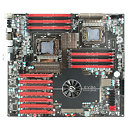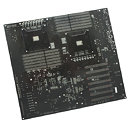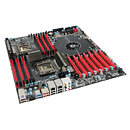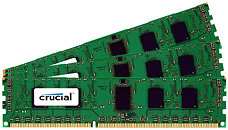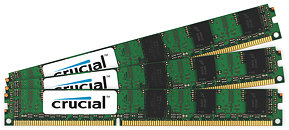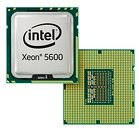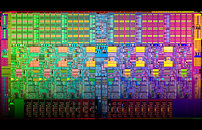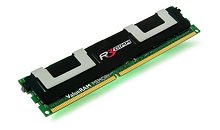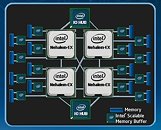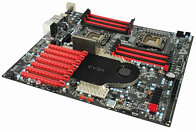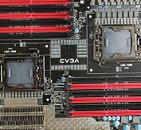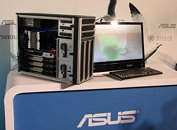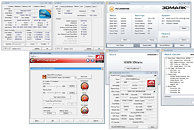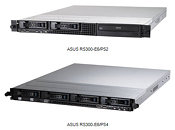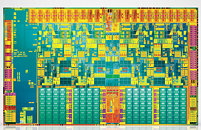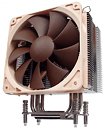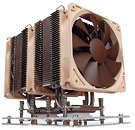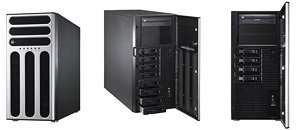
Intel is readying its fastest six-core processors ever. While the company is working to introduce the
Core i7 990X Extreme Edition for launch sometime in Q4 2010, it's already begun sampling the Xeon X5690. The X5690 is a dual-socket ready LGA1366 processor based on the 32 nm Westmere-EP silicon. It carries a nominal clock-speed of 3.46 GHz (26.0 x 133 MHz), with a Turbo Boost speed of 3.60 GHz (27.0 x 133 MHz). It features a QuickPath Interconnect speed of 6.4 GT/s, and supports triple-channel registered DDR3 memory with its integrated memory controller. Cache levels include 256 KB L2 cache per core, and 12 MB shared L3 cache.
The processor is compatible with most server boards based on the Intel 5500 and 5520 chipsets with BIOS updates. A quick overclocking feat by Fitseries3 on the EVGA Classified SR-2 motherboard yielded a speed of 5 GHz making use of the high BClk multiplier. The chip is likely to carry a rated TDP of 130W. Intel may release this processor in the next quarter, either displacing the X5680 from its US $1,730 price point, or occupying a higher one. The CPU-Z validation of the mentioned overclocking feat can be found
here.

During the International Supercomputing Conference (ISC), Intel Corporation announced plans to deliver new products based on the Intel Many Integrated Core (MIC) architecture that will create platforms running at trillions of calculations per second, while also retaining the benefits of standard Intel processors.
Targeting high-performance computing segments such as exploration, scientific research and financial or climate simulation, the first product, codenamed "Knights Corner," will be made on Intel's 22-nanometer manufacturing (nm) process - using transistor structures as small as 22 billionths of a meter - and will use Moore's Law to scale to more than 50 Intel processing cores on a single chip. While the vast majority of workloads will still run best on award-winning Intel Xeon processors, Intel MIC architecture will help accelerate select highly parallel applications.

Intel has once again shelved plans to come back to the discrete graphics market, with the much talked about GPU codenamed Larrabee. In a recent post by Director, Product and Technology Media Relations Bill Kircos on the company blog, it was detailed that the company's priorities at the moment lie with releasing industry-leading processors that have the graphics-processing horsepower for everyday computing. The Intel HD graphics will only get better with the 2011 series of Core processors based on the Sandy Bridge architecture, where the iGPU core will be completely integrated with the processing complex.
An unexpected yield of the Larrabee program seems to be that Intel has now perfected many-core processors. Since Larrabee essentially is a multi-core processor with over 32 IA x86 cores that handle graphics workload, it could as well give Intel a CPU that is Godsent for heavy-duty HPC applications. Intel has already demonstrated a derivative of this architecture, and is looking to induct it into its Xeon series of enterprise processors.

EVGA just released two of its most indigenous designs that marks a complete evolution from being a reference-design products vendor to an enthusiast-grade hardware giant: the much talked about EVGA Classified SR-2 dual-LGA1366 enthusiast-workstation motherboard, and power supply unit (PSU) tailor-made to suit systems based on the SR-2 motherboard. To begin with, the Classified SR-2 motherboard is a dual-LGA1366 motherboard supporting two dual-socket capable Intel Xeon E5500 series, and X5600 series quad-core and six-core processors. It is based on Intel's enterprise-grade 5520 chipset with ICH10R southbridge.
The Intel 5520 supports two QuickPath Interconnect paths to each of the sockets, which in turn can communicate with each other. Since each socket (processor) has its own triple-channel DDR3 memory controller, it has its own six DDR3 memory slots. The 5520 gives out two PCI-Express 2.0 x16 lanes which connect to two NVIDIA nForce 200 chips that give out two PCI-Express 2.0 x16 links each. With external x8 switching thrown into the mix, the motherboard manages a staggering seven PCI-Express x16 slots.

Lexar Media, a leading global provider of memory products for digital media, today introduced Crucial DDR3L-1333Mhz 1.35v energy-efficient server memory modules in support of the new Intel Xeon processor 5600 series. Available in 1GB, 2GB and 4GB RDIMM and VLP (very low profile) RDIMM modules, Crucial DDR3L memory modules are fully compatible and have been validated with the new Intel Xeon processor 5600 series. Servers across the enterprise, including those utilized for virtualization, data storage and processing, and blade servers will reap the benefits of new Crucial DDR3L memory. Crucial DDR3L memory is available through select resellers worldwide and online at
Crucial.com/server.
"The benefits of energy-efficient DDR3L memory are clear - most notably the significant reduction in memory sub-system energy consumption and overall system cooling demands. Moreover, these benefits come without sacrificing the performance gains our customers expect from Intel's next-generation servers," said Jim Jardine, Lexar Media senior worldwide product manager. "Additionally, all Crucial DDR3L 1.35v memory has been fully validated and certified compatible with the Intel Xeon Processor 5600 series, so customers can rest assured their server infrastructure investment will perform reliably and efficiently with Intel's newest processors."

Combining unprecedented security, performance and energy efficiency, Intel Corporation today launched the Intel Xeon Processor 5600 series. The new processors deliver two new security features -- Intel Advanced Encryption Standard New Instructions (Intel AES-NI), and Intel Trusted Execution Technology (Intel TXT) -- that enable faster encryption and decryption performance for more secure transactions and virtualized environments, providing data centers with a stronger foundation for cloud security.
These are also the first server and workstation chips based on the groundbreaking, new Intel 32nm logic technology, which uses Intel's second-generation high-k metal gate transistors to increase speed and decrease energy consumption. The Intel Xeon Processor 5600 series supports up to six cores per processor and delivers up to 60 percent greater performance than the 45nm Intel Xeon processor 5500 series. In addition, data centers can replace 15 single-core servers with a single new one, and achieve a return on their investment in as little as 5 months.

Kingston Technology Europe Ltd, a subsidiary of Kingston Technology Company, the independent world leader in memory products,today announced that its low-voltage registered dual inline memory modules (RDIMMs) have been validated for use in the upcoming Intel Westmere-EP processor-based server platforms. The Kingston ValueRAM DDR3L ('L' for low voltage) 1333MHz (1.35 volt) server RDIMMs were certified on Intel's Westmere reference platform.
Kingston is proud to offer customers our 1.35-volt server memory and having it certified for use with Intel's next-generation Xeon processors," said Stephane Rizzetto European Product Development Manager for DRAM of Kingston Technology. "Our low voltage registered server memory helps lower total cost of ownership in datacenters as it uses less power, thus producing less heat than equivalent 1.5-volt modules resulting in lower cooling costs for memory-dense servers."

Intel is set to introduce a series of eight-core Xeon server processors later this month, that are capable of running in four-socket servers. With HyperThreading technology enabled, each core can handle two threads, taking the logical CPU count on such servers up to 64. Each Nehalem-EX chip has 8 CPU cores with dedicated L2 caches of 256 KB, a shared L3 cache of 24 MB, and Turbo Boost technology that helps conserve power while also stepping up performance when needed. The die also features a memory controller with four DDR3 memory channels. Being based on the Nehalem architecture, the chips are built on the 45 nm HKMG process.
In related news, Intel will also introduce Westmere-EP processors later this month. These chips will be based on the 32 nm Westmere architecture, and are likely to have 6 cores, up to 12 logical CPUs per chip, 12 MB of L3 cache and three DDR3 memory channels. These chips will be suited for two-socket servers and workstations.

EVGA today named its dual-LGA1366 enthusiast-grade motherboard, so far known by the codename W555. After a short contest on the company's forums, the company came up with "EVGA Classified SR-2" for its name. SR stands for "super record" and 2 denoting the dual-socket design. The Classified SR-2 is a an entusiast-grade (read: overclocker friendly) implementation of the Tylersburg platform, supporting Intel socket LGA1366 processors with two QPI links (2P Xeon, etc.) As an addition, the board allows you to do something that's difficult on typical 2P server motherboards: it allows you to mix different models of Xeon processors, provided they're based on the same architecture, and series. For example, you can mix a Xeon 5520 with Xeon 5540. You can also mix a quad-core processor with a six-core processor, provided the quad-core part is based on the Westmere architecture (32 nm), not Nehalem (45 nm).
The board will also let you run a single 2P-capable processor in either sockets. DDR3 memory modules can be non-ECC or even ECC. 2P Xeon DRAM Multipliers / Uncore Multipliers are locked so you will only be able to use maximum 2:8 or 2:10 depending on segment of CPU. EVGA tells that the board supports 4-way SLI on its GTX 285 Classified VGA, but adds that a "future flagship GPU" also supports it. Could this be GeForce GTX 400 series having it as a standard feature? We have to wait and see. 4-way CrossFireX is supported.

Intel's Core i7 processor in the LGA1366 package is currently leading in the performance front, some of the fastest processors for the desktop platform fall in this league. Despite lacking a directly competitive processor, the platform had its share of competition thanks to motherboard manufacturers competing within themselves. EVGA for one, is set to
unveil a bleeding-edge motherboard later this year, which supports two LGA1366 processors. So far, enthusiasts working for EVGA have only disclosed that the motherboard would work with Intel's DP Xeon 5000 series LGA1366 processors, which are officially capable of working on dual-socket server and workstation motherboards.
However, a plausible rumor doing rounds has it that EVGA may attempt to make its motherboard work with Core i7 series processors - which are incapable to operate in pairs, at least from what we're led to believe. EVGA is attempting to do this by modifying the reference Intel design for the platform.

EVGA is keeping up its streak of releasing high-end motherboards for processors based on the new Intel Nehalem architecture, with a new dual-socket monstrosity. Slated for CES 2010, not much about this high-end workstation motherboard has been revealed beyond the picture below. From the looks of it, probably EVGA is making a high-end, overclocker-friendly dual LGA-1366 motherboard based on the Intel 5500 "Tylersburg" chipset with the usual ICH10R southbridge. Existing LGA-1366 processors that support dual-socket operation which includes Xeon 5500 series may work on it. Probably, a future high-end Intel Core family CPU is released that is capable of dual-socket setups, too. The picture reveals two LGA-1366 sockets, each powered by an 8-phase digital PWM circuit. Each socket is wired to six DDR3 DIMM slots supporting triple-channel memory for that socket. More this CES.

Outgrowing the known lineup of 32 nm client processors (under the Core family), Intel's upcoming lineup of processors based on the 32 nm Westmere architecture will comprise of no less than 13 models under the Xeon E5000, L5000, X5000, and W3600 series. Among these, there are six hexa-core Xeon processors, including X5680 (3.33 GHz), X5670 (2.93 GHz), X5660 (2.80 GHz), and X5650 (2.66 GHz). X5680 has a TDP of 130W, with the latter three sub 3 GHz models having TDP as low as 95W. There is an energy-efficient L5640 hexa-core model clocked at 2.26 GHz, with TDP at 60W, and a single-socket W3680, clocked at 3.33 GHz with 130W TDP. All these models have six cores, and 12 MB of L3 cache.
Next up, are Intel's first 32 nm quad-core processors: Xeon X5677 (3.46 GHz, 130W), X5647 (3.06 GHz, 95W), E5640 (2.66 GHz, 80W), X5630 (2.53 GHz, 80W), X5620 (2.40 GHz, 80W), and energy efficient L5630 (2.13 GHz, 40W), and L5609 (1.86 GHz, 40W). Except L5609, all these quad-core chips have HyperThreading Technology and Turbo Boost available. The L2 cache amounts for each of these chips is unknown as of now, but should be up to 8 MB, or as low as 4 MB for some models. Most of these chips are slated for release on March 16, 2010.

Intel Corporation and NEC Corporation today have agreed to jointly develop High Performance Computing (HPC) system technologies that will push the boundaries of supercomputing performance. NEC will bring these technologies to market in future supercomputers based on the Intel Xeon processor. NEC's expertise in this field coupled with the Intel Xeon processor's outstanding performance and its accelerating vector capabilities such as AVX will allow for higher performance supercomputers, satisfying customer demand for Intel architecture based products.
NEC will also continue to sell their existing SX vector processor-based products. A vector processor can perform a mathematical operation on several numbers simultaneously.
"Intel's substantial investment in the Intel architecture, including the development of processors, chipsets, software compilers and other related products has expanded the usages of Intel Xeon processors in both the volume and high-end HPC market segments," said Richard Dracott, general manager of Intel's High Performance Computing Group. "Now with NEC further innovating on Intel Xeon processor-based systems, Intel is poised to bring Intel Xeon processor performance to an even wider supercomputing audience."

Following AMD's recent success of its 6-core Opteron processor in the TOP500 supercomputer list, Intel has sensed a market for "HPC-optimized" processors, which the company expects will be out in the first half of 2010. These could be either variants of the Nehalem-EX multi-socket capable processors, or that by design, Nehalem-EX suits HPC (high-performance computing) applications better.
These 6-core processors will carry clock speeds higher than 8-core Xeon processors around that time. The processors will be able to work in systems with up to 256 processors (logical CPUs). In addition to these Intel also announced that it will be releasing a beta version of its Ct technology by the end of this year. Ct makes parallel programming in the C and C++ programming languages easier, by automatically optimizing code to exploit multi-core and many-core systems.

Intel updated its socket LGA-1366 Xeon processor portfolio with the W3565. Based on the Nehalem architecture, this quad-core processor is made for single-socket servers and workstations. It has near-identical specifications to the consumer-grade Core i7 960, in having a clock speed of 3.20 GHz (24 x 133 MHz), 8 MB of L3 cache, and a QuickPath Interconnect (QPI) speed of 4.8 GT/s. The QPI speed is perhaps the only thing that differentiates it from the W3570, which has the same clock speed, albeit a QPI speed of 6.4 GT/s. This one specification makes for a large price difference. While the new W3565 is priced at $562, the W3570 is priced at $999. With the introduction of the new processor, Intel is set to retire the 2.93 GHz W3540, and 3.06 GHz W3550.

ASUS, in collaboration with NVIDIA and the National Chao Tung University of Taiwan, has introduced the ESC 1000 desktop-sized supercomputer, that harnesses the power of GPGPU, to give out 1.1 TFLOPs of computational power. Enclosed in a 445 x 217.5 x 545 mm chassis (the size of tower server/workstation chassis,) is a system powered by an Intel Xeon W3580 "Nehalem" 3.33 GHz processor, aided by 24 GB of system memory. As many as three NVIDIA Tesla c1060 GPGPU cards are installed, with an NVIDIA Quadro FX 5800 handing graphics. These emphasize that the system is meant for highly complex visual computing, such as in the fields of highly complex modeling, and scientific research. The pricing and availability of the ESC 1000 is not known as yet.

Intel Corporation today reported third-quarter revenue of $9.4 billion. The company reported operating income of $2.6 billion, net income of $1.9 billion and earnings per share (EPS) of 33 cents.
"Intel's strong third-quarter results underscore that computing is essential to people's lives, proving the importance of technology innovation in leading an economic recovery," said Paul Otellini, Intel president and CEO. "This momentum in the current economic climate, plus our product leadership, gives us confidence about our business prospects going forward. As we look ahead, Intel's game-changing 32nm process technology will usher in another wave of innovation from new, powerful Intel Xeon server platforms to high-performance Intel Core processors to low-power Intel Atom processors."
Highlights include:
- Third-Quarter Revenue $9.4 Billion, Strongest Second-to-Third-Quarter Growth in over 30 years
- Gross Margin 58 Percent, Up 7 Points Sequentially
- Operating Income $2.6 Billion
- Net Income $1.9 Billion
- EPS 33 Cents
To read the complete earnings release, visit
this page.

The Dutch techsite tweakers.net set a new world record for 3Dmark03. While the old record (180,349) was set using four 4890s the new record uses only three 5870s and a Xeon W3540 clocked at 5231 MHz. The 5870s ran at 1200 MHz with only slightly overclocked memory at 4900 MHz.

ASUS today announced the launch of its new RS300-E6 Series servers featuring the Intel 3420 PCH chipset and Intel Xeon 3400 Series Processors. With dual or quad core processor configurations, the RS300-E6 Series can scale up performance immediately to support high-volume workloads. Comprising the RS300-E6/PS2 and RS300-E6/PS4 models, the series comes in a 1U form factor housing a single-package processor. Additionally, with its expansion options, the series provides exceptional upgrade capabilities.

Intel Corporation today disclosed new information about next-generation Intel Xeon processors - codenamed "Jasper Forest" - for communications and storage applications, due in early 2010. With Jasper Forest, Intel engineers have, for the first time, integrated PCI Express (PCIe) in a dual-processing Xeon processor, which greatly facilitates dense storage and communications solutions such as IPTV, VoIP, NAS, SAN and wireless radio network controllers.
Jasper Forest maintains the outstanding performance of Intel architecture (Nehalem), while lowering system power consumption by 27 watts when compared to the Intel Xeon 5500 series processors. The dual-processing solution integrates two Jasper Forest processors with 16 PCIe Generation 2.0 lanes each and is paired with the Intel 3420 chipset platform controller hub. This integration of the I/O hub via PCIe enables significant power and space savings, resulting in one of the highest performance-per-watt Intel Xeon chips ever.

Intel Corporation introduced several high-performance desktop and server processors today, bringing the next level of integration and intelligence to computers. The new Intel Core i5 processor family, two new Intel Core i7 processors and the Intel Xeon processor 3400 series bring Intel's latest Nehalem microarchitecture to mainstream desktop and entry server markets.

Intel expanded its portfolio of Xeon enterprise processors with four new models: the dual-socket W5590, L5530, and single-socket W3580 and W3550. With this batch of releases, Intel introduces 3.33 GHz Xeon models. To begin with, W5590 comes with a clock speed of 3.33 GHz, and Quickpath Interconnect speed of 6.4 GT/s. It features 8 MB of L3 cache to aid its four HyperThreading-enabled cores. This model is trailed by the single-socket W3580 that carries the same specs of 3.33 GHz core speed, 8 MB L3 cache, and HyperThreading enabled. Another single-socket model, W3550, is clocked at 3.06 GHz. It has a narrower 4.8 GT/s QPI speed, 8 MB L3 cache, HyperThreading enabled. All these chips have their TDP rated at 130W. Finally, there's the low-wattage L5530. This dual-socket chip is clocked at 2.40 GHz, QPI speed of 5.83 GT/s, 8 MB L3 cache, and TDP rating of a mere 60W.

Intel's upcoming processor and compatible platform launch schedule gained some clarity today with tentative launch dates and time-frames surfacing from industry sources. Highlights on the client front include:
- Desktop platform initially based on Lynnfield quad-core processor and P55 chipset to be out between September 8~11
- Three recently detailed mobile quad-core processor models based on the Clarksfield core will be announced towards the end of September or early October
- Around the same time as above, Intel will release two new budget chips for its CULV platform, called Celeron SU2300 and Celeron 743. Expect these to be toned-down variants of the existing Core 2 CULV chips

Noctua today presented two new additions to its DX series of quiet Intel Xeon CPU coolers: Now compatible with Intel's latest LGA1366 based Xeon 5500 (Nehalem EP) processors, the new NH-U12DX 1366 and NH-U9DX 1366 are true drop-in replacements for standard Intel coolers and make it easier than ever before to significantly reduce the noise emission of high-end workstations and severs.

ASUS, the leading producer of servers and workstations, recently announced the availability of its latest 5U pedestal and rack-mountable servers and workstations-the ASUS TS700-E6/RS8 and TS500-E6/PS4. Both are based on Dual and Quad-Core Intel Xeon Processor 5500 series platforms with DDR3 memory and PCIe 2.0 support. They also feature additional expansion slots which can also be used for a dedicated graphics card, a MIO network card and other expansion options for personal workstation use-providing customers with high flexibility, reliability, storage capacity and expandability.

